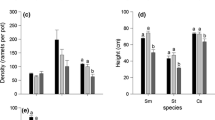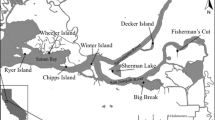Abstract
Egeria densa and Elodea canadensis are two common invasive submerged macrophytes in streams and rivers worldwide. We conducted a six-week growth experiment with monocultures of E. densa and E. canadensis and mixed communities of the two species under five different shade levels (35%, 63%, 79%, 90% and 95%). Our aim was to test the effect of shade and competition on colonization of vegetative propagules of these species in flowing waters. We found that biomass accrual in both species was greatly reduced at high shade (≥ 79%) and that E. densa individuals accrued more biomass than E. canadensis individuals at all shade levels. At the least shade level (35%), interspecific competition with E. densa stimulated biomass accrual of E. canadensis individuals, compared to those within an E. canadensis monoculture. At higher shade (≥ 63%), this facilitation response disappeared, although E. canadensis plants continued to have longer stem length and a greater degree of branching than E. densa plants at ≤ 79% shade. At the highest shade level, competition with E. canadensis reduced biomass accrual of E. densa. Hence, shade influenced the competitive interactions between these two species. At low shade, the competitiveness of E. canadensis was enhanced, but in the field E. densa appears to be the dominant species in streams, especially those with higher levels of shade and less frequent disturbance by flushing flow events.


Similar content being viewed by others
References
Alnoe AB, Riis T, Andersen M, Baattrup-Pedersen A, Sand Jensen K (2015) Whole stream metabolism in nutrient poor calcareous streams on Oland. Sweden Aquat Sci 77(2):207–219
Barko JW, Smart RM (1981) Comparative influences of light and temperature on the growth and metabolism of selected submersed freshwater macrophytes. Ecol Monogr 51(2):219–235
Bell N, Riis T, Suren AM, Baattrup-Pedersen A (2013) Distribution of invertebrates within beds of two morphological contrasting stream macrophyte species. Fund Appl Limnol 183:309–321
Borgnis E, Boyer KE (2016) Salinity tolerance and competition drive distributions of native and invasive submerged aquatic vegetation in the upper San Francisco estuary. Estuar Coast 39:707–717
Champion PD, Tanner CC (2000) Seasonality of macrophytes and interaction with flow in a New Zealand lowland stream. Hydrobiologia 441(1):1–12
Champion PD, de Winton MD, Clayton J (2014) A risk assessment based proactive management strategy for aquatic weeds in New Zealand. Manag Biol Invasions 5(3):233–240
Champion P, Rowe D, Smith B, Wells R, Kilroy C, de Winton M (2013) Freshwater pests of New Zealand. https://www.niwa.co.nz/sites/niwa.co.nz/files/sites/default/files/pest_guide_lndscp_feb_2013_pdf. Accessed 4 December 2018
Connolly J, Wayne P, Bazzaz FA (2001) Interspecific competition in plants: how well do current methods answer fundamental questions? Am Nat 157:107–125
Davidson AM, Jennions M, Nicotra AB (2011) Do invasive species show higher phenotypic plasticity than native species and if so, is it adaptive? A meta-analysis. Ecol Lett 14:419–431
Eller F, Alnoe AB, Boderskov T, Guo W, Kamp AT, Sorrell BK, Brix H (2015) Invasive submerged freshwater macrophytes are more plastic in their response to light intensity than to the availability of free CO2 in air-equilibrated water. Freshw Biol 60:929–943
Evangelista HB, Michelan TS, Gomes LC, Thomaz SM (2017) Shade provided by riparian plants and biotic resistance by macrophytes reduce the establishment of an invasive Poaceae. J Appl Ecol 54:648–656
Hao B, Wu H, Shi Q, Liu G, Xing W (2013) Facilitation and competition among foundation species of submerged macrophytes threatened by severe eutrophication and implications for restoration. Ecol Eng 60:76–80
Harper JL (1977) Population biology of plants. Academic Press, New York
Hoffmann WA, Poorter H (2002) Avoiding bias in calculation of relative growth rate. Ann Bot (Lond) 80:32–47
Hofstra DE, Clayton J, Green JD, Auger M (1999) Competitive performance of Hydrilla verticillata in New Zealand. Aquat Bot 63:305–324
Kankanamge CE, Matheson FE, Riis T (2019) Shading constrains the growth of invasive submerged macrophytes in streams. Aquat Bot 158:103125
Lacoul P, Freedman B (2006) Environmental influences on aquatic plants in freshwater ecosystems. Environ Rev 14:89–136
Levi PS, Riis T, Alnoe AB, Peipoch P, Maetzke K, Bruus C, Baattrup- Pedersen A (2015) Macrophyte complexity controls nutrient uptake in lowland streams. Ecosystems 18(5):914–931
Li F, Yang N, Zhu L, Xie Y, Yang G, Hu C, Chen X, Deng Z (2018) Competition and facilitation of two wetland macrophytes under different water levels and nutrient-heterogeneous conditions. Freshw Sci 37(2):296–306
Maestre FT, Callaway RM, Valladares F, Lortie CJ (2009) Refining the stress-gradient hypothesis for competition and facilitation in plant communities. J Ecol 97:199–205
Martin GD, Coetzee JA (2014) Competition between two aquatic macrophytes, Lagarosiphon major (Ridley) Moss (Hydrocharitaceae) and Myriophyllum spicatum Linnaeus (Haloragaceae) as influenced by substrate sediment and nutrients. Aquat Bot 114:1–11
Mony C, Koschnick TJ, Haller WT, Muller S (2007) Competition between two invasive Hydrocharitaceae (Hydrilla verticillata (L.f.) (Royle) and Egeria densa (Planch)) as influenced by sediment fertility and season. Aquat Bot 86:236–242
Milne JM, Lang P, Murphy KJ (2007) Competitive interactions between Salvinia auriculata Aubl., Limnobium laevigatum (Humb. and Bonpl. ex Willd.) Heine, and other free-floating aquatic macrophytes under varying nutrient availability. Fund Appl Limnol 169:169–176
Redekop P, Hofstra D, Hussner A (2016) Elodea canadensis shows a higher dispersal capacity via fragmentation than Egeria densa and Lagarosiphon major. Aquat Bot 130:45–49
Riis T (2008) Dispersal and colonisation of plants in lowland streams: success rates and bottlenecks. Hydrobiologia 596:341–351
Riis T, Sand-Jensen K (2006) Dispersal of plant fragments in small streams. Freshw Biol 51:274–286
Riis T, Olesen B, Clayton JS, Lambertini C, Brix H, Sorrell BK (2012) Growth and morphology in relation to temperature and light availability during the establishment of three invasive aquatic plant species. Aquat Bot 102:56–64
Sand-Jensen K (2002) Drag and reconfiguration of freshwater macrophytes. Freshw Biol 48:271–283
Thiébaut G, Rodriguez-Perez H, Jambon O (2019) Reciprocal interactions between the native Mentha aquatica and the invasive Ludwigia hexapetala in an outdoor experiment. Aquat Bot 157:17–23
Vila M, Weiner J (2004) Are invasive plant species better competitors than native plant species? Evidence from pair-wise experiments. Oikos 105:229–238
You WH, Han CM, Fang LX, Du DL (2016) Propagule pressure, habitat conditions and clonal integration influence the establishment and growth of an invasive clonal plant Alternanthera philoxeroides. Front Plant Sci 7:568
Zefferman E (2014) Increasing canopy shading reduces growth but not establishment of Elodea nuttallii and Myriophyllum spicatum in stream channels. Hydrobiologia 734:159–170
Acknowledgements
Funding for this study was provided by the New Zealand Ministry for Business, Innovation and Employment to the National Institute of Water and Atmospheric Research (Strategic Science Investment Project: SMARTer Riparian & Wetland Strategies). The authors thank M. Crump and D. Rendle for technical support. We also thank Champion P for his valuable comments on anearlier version of this manuscript.
Author information
Authors and Affiliations
Corresponding author
Additional information
Handling Editor: Télesphore Sime-Ngando
Publisher's Note
Springer Nature remains neutral with regard to jurisdictional claims in published maps and institutional affiliations.
Rights and permissions
About this article
Cite this article
Ellawala Kankanamge, C., Matheson, F.E. & Riis, T. Shading may alter the colonization pattern and dominance between two invasive submerged aquatic plant species. Aquat Ecol 54, 721–728 (2020). https://doi.org/10.1007/s10452-020-09770-0
Received:
Accepted:
Published:
Issue Date:
DOI: https://doi.org/10.1007/s10452-020-09770-0




